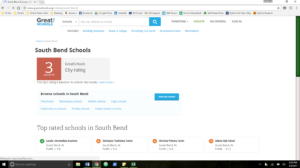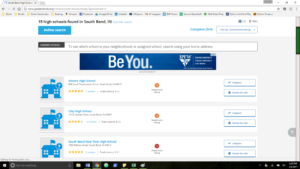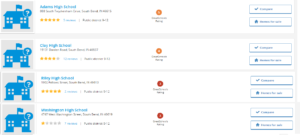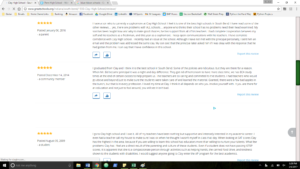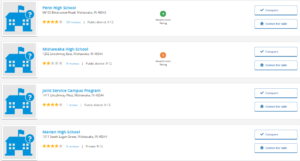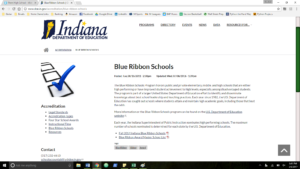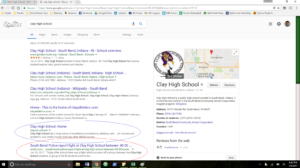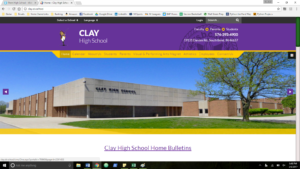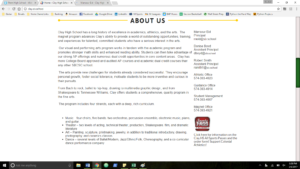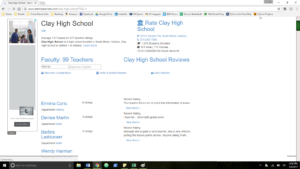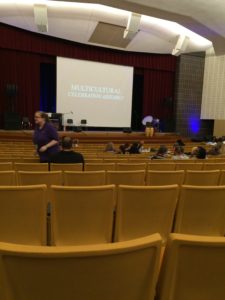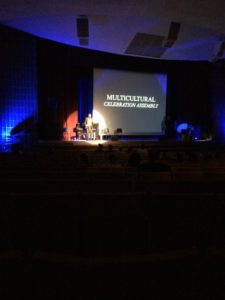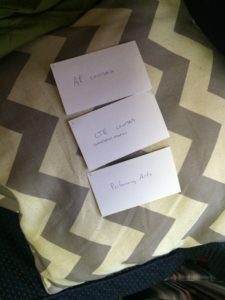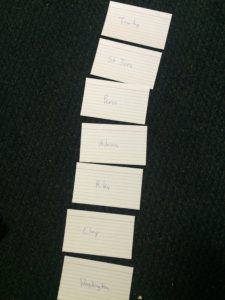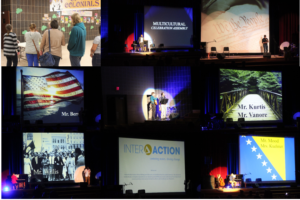Individual Interview 1 – Danny Cohen
Date: 2/25/2017
Type: Individual Interview with former Clay student currently at Notre Dame
User: Tess Swain is a junior at Notre Dame studying Marketing, originally from South Bend, IN. She attended Clay High School, and had a wonderful experience as a student there. I reached out to her per the suggestion of another interviewee, and had to contact her via email because she was abroad, so I was not able to obtain any video footage of the interview.
Summary of Interview:
Entice:
What enticed her to attend Clay High School versus the alternative options?
- Family ties; seeing her siblings have a successful experience at Clay
- Proximity; Clay was the closest high school to her house
- Similarity; in her mind, all four public schools are almost the same
- Convenience; easy to get to, and already informed about it due to siblings attending
- Price; being a public school, it was a cheaper option than a private school like St. Joe
Overall, it seems that Tess and her parents had a relatively easy decision in choosing to send their kids to Clay High School. They used the experience of their older siblings to determine that it was a good school, and their initial motivation seemed to be motivated by convenience, price, and the relatively-similar academic experience that she could get at other schools.
Enter:
The way that Tess entered into Clay was simply to enroll in the school. Since it was the closest to her high school, it was easy for her to get to the school, and since the school is public, there are no admissions exams or requirements that she had to meet.
Engage:
- Entering into the school community, and becoming a part of it.
- Activities: Trick-or-Treating, Serving, Chanting, Playing Sports, Learning, Growing, Being Challenged, Being Supported
- Some of the objects that Tess addressed were things like athletic events, service events, and learning in the classroom. These are the things that students are physically involved in when they’re at school, and evidently they are big contributors to a students’ enjoyment and success throughout high school.
- Many of her interactions that she described were with staff members. Each day, students interact with teachers, principals, coaches, and more, and parents are likely concerned with how these adults mold and support their children. According to Tess, they did an excellent job.
Exit:
- Currently, Tess is a student at Notre Dame.
- The primary step in the exit process is graduation. Many parents would likely be concerned with their student graduating from high school, which is why graduation statistics are very important.
- It could be useful to highlight successful alumni who go on to do great things, like Tess, because this shows the type of student that Clay creates.
Extend:
- Once students leave high school, they tend to have limited interaction with the school. If they have siblings, like in Tess’s case, they might encourage them to attend the same school. It seems that with families, it’s rare for parents to send their kids to different high schools. Because of this, Clay should focus on attracting parents who haven’t yet decided on a school for their oldest child, in an attempt to get younger siblings into the school as well.
Tess also provided a lot of insight on the challenges facing Clay, and addressed some of the reasons why parents might send their kids to schools besides Clay. Some of the main observations she had were:
- Adams is currently the most popular school to attend, due to friend groups, the IB program, and superior athletics.
- Losing kids to Adams creates a drain-effect, where parents start to perceive it as the better school because more kids are going there, and this domino-effect leads to enrollment challenges for the other three public schools.
- Some parents believe their kids will have a better shot at college or college athletics if they attend Adams.
- Clay is rumored to have the worst magnet program of the 4 public schools.
- Perception is that Clay is filled with fighting, has kids who don’t take school seriously, and receive a worse education.
Finally, Tess gave some advice on how Clay might be able to better market themselves to prospective families.
- Increase the selection of classes, to draw back kids that are flocking to Adams for the IB courses.
- Label of “Fine Arts Magnet” can be detrimental to the school’s image, if parents believe that arts are all that Clay has to offer.
- Increased college preparation courses. This ties back into a point that Tess made about the perception that Clay might not excel at sending kids to college, and improving this could show parents that Clay is serious about the educational future of its students.
Overall, it seems that a lot of the challenges facing Clay are due to its image. People aren’t necessarily concerned with the statistics or facts about the school; rather, it seems that Clay has a problem with its image. Tess says throughout that she “has heard” things like fights being started, or issues with the magnet program, or that the school has gone downhill. This makes me question if parents are truly concerned with the statistics about the school, or if image, rumors, and advice from friends plays a much larger role in their decision.
Significant Quotes:
“I never even considered the other SB public schools because while they may have some variation of pros and cons, at the end of the day all four schools are virtually the same.”
“However, [St. Joe] was too expensive, and I knew Clay would offer me the exact same opportunities.”
“What I valued most about Clay was the sense of community.”
“[Clay teachers] care so deeply about not only how the students perform in the classroom but what kind of people they go on to become. I always felt that I was being challenged and rooted for, and I think that’s a very important thing to be able to say.”
“ I have also heard repeatedly that Clay has the worst magnet program of the four which may deter people from enrolling.”
“ I’ve heard people say that the kids start fights, don’t take school seriously, and receive a lesser education.”
“I feel that the label “Fine Arts magnet” is more harmful to Clay than the actual magnet itself.”
“While I thought Clay prepared me fairly well for college, some of my classmates strongly disagreed. We took one required career class freshman year which was not incredibly useful, so I think strengthening that type of requirement as well could be really helpful for students.”
Transcript from Interview:
Why did you decide to attend Clay, versus the other SB public schools? Private schools?
I went to Clay because my three older siblings did. They loved it, and it is the closest high school to my house so it was really a no brainer. I never even considered the other SB public schools because while they may have some variation of pros and cons, at the end of the day all four schools are virtually the same. My mom went to Adams and only has positive things to say about it but did not hesitate in sending us to Clay. It was the most convenient choice and gave us the same education/experience that she got at Adams.
Regarding private schools, I almost went to St. Joe because I grew up playing softball with their feeder team, so all of my teammates went on to school there. However, it was too expensive, and I knew Clay would offer me the exact same opportunities.
If you were trying to convince a middle-school parent to send their student to Clay, how would you do it? Essentially, what are the best selling points of Clay?
What I valued most about Clay was the sense of community. Traditions like the signature Canned Food Drive, trick-or-treating for the Evan Halford Foundation, and chanting with Derb at football/basketball games are unique to Clay and are some of my fondest memories. Teachers like Mrs. O’Blenis, Mr. Romans, and Mr. Kasper live for their students. They care so deeply about not only how the students perform in the classroom but what kind of people they go on to become. I always felt that I was being challenged and rooted for, and I think that’s a very important thing to be able to say. I also think Clay is a very welcoming place. With the variety sports/clubs/extra-curriculars available in addition to the Fine Arts magnet, there is something for everyone, and that harbors diversity.
Why do you believe a parent might choose NOT to send their student to Clay? What are some of the negative stereotypes associated with the school?
Right now, Adams is the “cool” school to go to. More and more kids want to follow their friends there, join the IB program, or go for athletics because their sports teams are now loaded due to increased enrollment. Adams’ rise to prominence negatively affects Clay, Riley, and Washington alike. Parents may not send their kids to Clay because they feel that they could get a better education or a better chance at college athletics by going to Adams. I have also heard repeatedly that Clay has the worst magnet program of the four which may deter people from enrolling. Clay currently has somewhat of a reputation that it has “gone downhill.” I’ve heard people say that the kids start fights, don’t take school seriously, and receive a lesser education.
What advice would you have for Clay to improve their student experience? More AP classes? Less focus on arts? More college prep classes?
I loved my experience at Clay, so this question is kind of hard to answer. I think more AP classes would be good and would certainly help take back some of the crowd that is rushing to Adams’ IB program. If possible, I think a wider selection of classes in general would help attract more students. I feel that the label “Fine Arts magnet” is more harmful to Clay than the actual magnet itself. I didn’t think there was too heavy of a focus on the arts or that the magnet detracted at all from other areas of study. But the magnet does target a niche audience and being pegged as a fine arts school dissuades some from attending. Some think that’s all Clay has to offer. More college prep classes would be incredibly beneficial. While I thought Clay prepared me fairly well for college, some of my classmates strongly disagreed. We took one required career class freshman year which was not incredibly useful, so I think strengthening that type of requirement as well could be really helpful for students.
